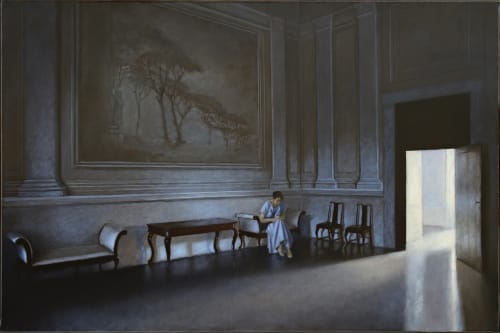This exhibition, Le Souvenir et l’Oubli, immerses us in the poetic universe of Geneviève Daël, which is as intimate as it is enigmatic.
In this new series of paintings, female figures are depicted in palaces, historic houses, and castles; places that bear witness to a grandeur that no longer exists. The silence and emptiness that inhabit these spaces reflect the stillness that characterises Dael's figures.
It is above all in Italy that the artist travels, in search of those places, once, but no longer, inhabited, which plunge us into timeless spaces, in an Italy as evoked by Stendhal, "of solitude and isolation, where the soul, left alone with itself, joyfully discovers that it can do without the world"1.
Each painting contains its share of mystery, and many questions remain unanswered. The silence seems absolute and pushes the viewer to a reflective gaze. What is this woman, who is almost always turned towards the light, thinking? Is her loneliness filled with memories or forgetfulness? The viewer can only find an answer in his or her own interpretation, in the emotions that the painting will give rise to in them. The mystery inherent in these interior scenes is strengthened by the architectural spaces in which they take place. Sometimes seen through a worn mirror, sometimes made complex by a succession of opened doors or rooms in enfilade, the viewer's eye plunges into it as if trying to unravel the enigma.
However, it is undoubtedly the delicacy with which Geneviève Daël represents light that gives her works their most appealing aspect. With exquisite subtlety the greys which are so dominant in the artist's palette permeate the ambient light, which then transforms the atmosphere of the space. As windows, a central element in the artist's work, project light beams onto the elements that inhabit these interiors, our eyes are drawn and transfixed by its coloured effects on a column, a tablecloth, a marble tile, or wooden cabinet. Daël's poetry is bound to the texture of the painting shaped by shadow and light, which will resonate differently in each of us.
1 Fernandez, D. (2008). Dictionnaire amoureux de l'Italie, Volume II. Paris : Plon

